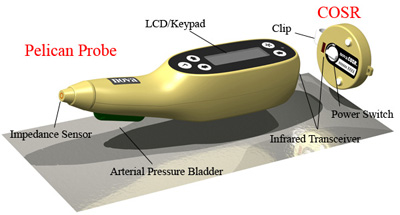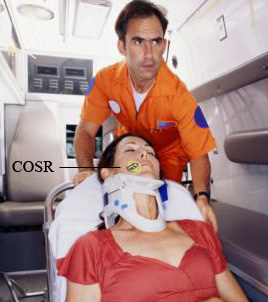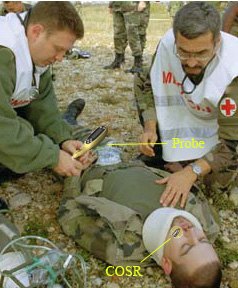|
The Pelican system also provides the first responder with traditional vital sign information.
Medevac and hospital personnel will have clear history of each patient's vital signs from the initial
time of contact with a first responder. Having a record of patient status from the time of contact facilitates
a more comprehensive and accurate evaluation of patient status.
The NOVA Pelican system consists of two major components: the Pelican probe and the Clip–On Sensor-Recorder (COSR).
The two components work together to monitor patient status and provide information to medical personnel in a clear,
concise form. The Pelican probe measures skin impedance using the two concentric electrodes on its tip. A clinical
trial is underway to investigate the clinical utility of impedance in diagnosis and management of hemorrhagic shock.
The Pelican system also measures mean arterial pressure using a bladder located on the neck of the probe. Working
independently of the Pelican probe, the COSR continuously monitors and records heart rate, oral temperature, and SpO2.
A first responder clips the COSR onto the cheek of a patient with the sensor inside the mouth. The clip itself is
comfortable and non-intrusive, and thin enough so that it does not interfere with an oxygen mask. Prompts on the
Pelican probe display guide the first responder through the process of taking readings and synchronizing with the COSR.
Information is transferred between the COSR and the Pelican probe via an infrared communication link. The first responder
has all of the information gathered by the COSR, as well as mean arterial pressure and skin impedance, displayed
on the Pelican probe screen. Also visible will be menu choices that allow the first responder to monitor vital sign trends
over time.
The Pelican probe communicates with a single COSR at any time. The first responder can monitor multiple patients with no
risk of interchanging patient data. The COSR remains with the patient from the time it is put in place
by the first responder at the accident site until the patient arrives at a hospital or other care facility. At
that point, information can be transferred to a PC for visual display of complete vital sign history.
CAUTION: Investigational device. Limited by federal law to investigational use.
|






